Behavioral Neuroscience, lecture on Honey Bee and its behavior
Honey Bee Conditioned Drinking
I. Honey Bee Arthropod in the Class: Insecta, Order: Hymenoptera
A. Any bee in the genus Apis (Latin for “bee”)
1. Seven recognized species
a. Apis mellifera (“bee”, “honey-bearing”): Western honey bee is most recognized
i. Also called the European honey bee 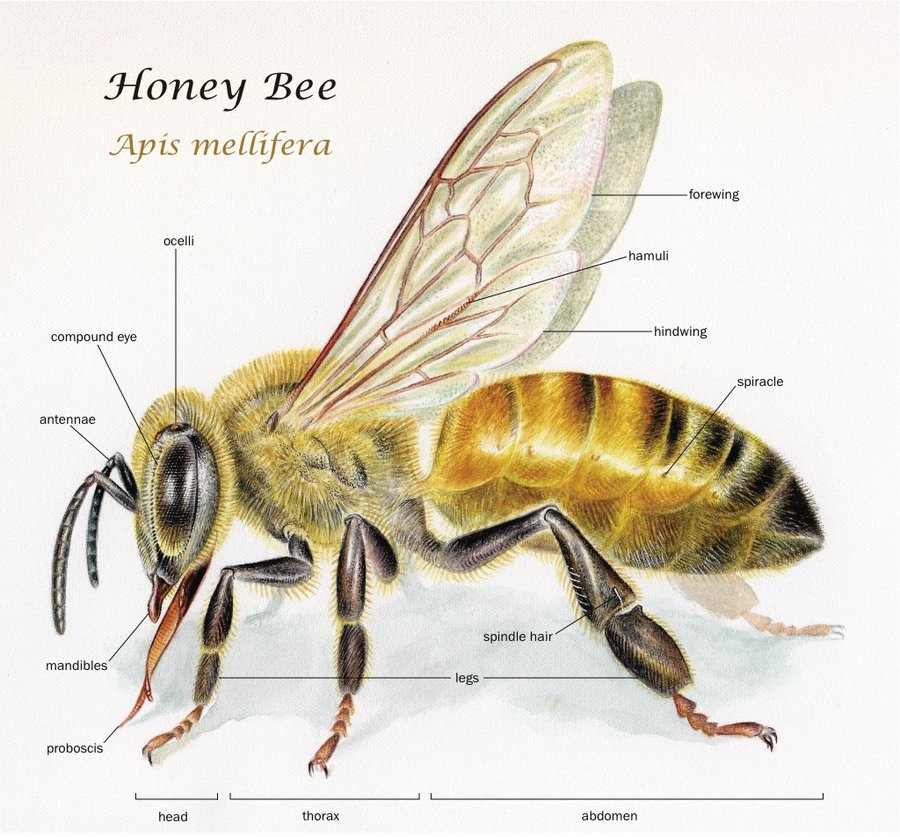 ii. Brought from Europe and domesticated for honey production and crop pollination
B. Segmented Body – exoskeleton
1. Head
ii. Brought from Europe and domesticated for honey production and crop pollination
B. Segmented Body – exoskeleton
1. Head 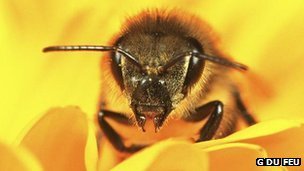 a. antennae
i. composed on flagellum, pedicel, and scape
ii. 1° source of sensory information under low light conditions
1) Mechanoreceptors: touch
a) Also hearing
i) sense movement of air particles
2) Odor receptors: olfaction = smell
a) detect odorant molecules
3) Gustatory receptors: taste
b. brain
c. eyes
d. proboscis
i. used for taking in liquids
a) Nectar, water, and honey
2. Thorax
a. antennae
i. composed on flagellum, pedicel, and scape
ii. 1° source of sensory information under low light conditions
1) Mechanoreceptors: touch
a) Also hearing
i) sense movement of air particles
2) Odor receptors: olfaction = smell
a) detect odorant molecules
3) Gustatory receptors: taste
b. brain
c. eyes
d. proboscis
i. used for taking in liquids
a) Nectar, water, and honey
2. Thorax 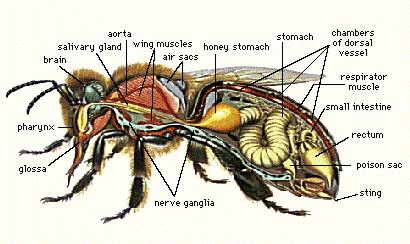 a. Two pairs of wings
b. Three pairs of legs
i. Pollen baskets
1) located on the tibia of the hind leg
2) Lined with hairs and a long central bristle to hold onto pollen
3. Abdomen
a. Wax-producing glands (8)
i. wax scales
b. Digestive tract
c. Reproductive system
i. Females:
1) only fully developed in Queens
2) most individuals are female = workers
a) Stinger
ii. Males = drones
1) primarily exist for reproduction
a) haploid
2) fully developed testes
3) Mid-flight mating with Queen
a) lethal for males
C. Worldwide Distribution
1. Occupies every continent
a. except Antarctica
D. Bee Life Cycle
1. “Worker” bee
a. Eggs laid by single fertile Queen bee
i. Maintained and fed by “nurse” bees
b. Reach adulthood with 2-3 weeks
i. then proceed through several behavioral phenotypes
1) Nurse bee
a) cleaning the hive and feeding young
2) build comb cells
a) after royal jelly glands atrophy
b) receive nectar and pollen from foragers
3) Forager
a) older workers outside the hive
2. Queen bee
a. eggs laid in queen cups
b. fed royal jelly
i. from glands on young workers
c. developement of sexually mature female
i. due to protein-rich diet
d. Swarm
i. mating with 12-15 drones
ii. sperm storage
e. Only fertile female in the colony
i. lays 1,500 egges / day
1) during spring
f. lives 2 - 7 more years
E. Colony Life Cycle
1. Continue year after year
2. Can contain anywhere between 40,000 and 80,000 bees
3. Yearly “swarms” usually occur in the spring (may occur more or less often)
a. splitting the colony to establish a new hive
i. Requires a new queen to be born
ii. May occur when hive is too full
1) queen becomes too old, or queen dies suddenly
F. Survival
1. Thermoregulation
a. T°body 34°C is necessary for flight
i. cooler T° à shivering before flight
ii. hotter T° à regurgitate warm internal fluid
1) honey-sac contents à evaporate cooling
b. 34°C maintained in the hive
i. development of young
ii. optimal for wax creation
c. Optimal foraging T° = 22-25°C
d. immobile under 7°C
i. winter clusters
1) workers shiver à 27 - 34°C
a) edges 8-9°C
ii. winter bees livel longer
2. Predators
a. Insects
i. hornets, wasps, robber flies, dragonflies, praying mantis...
b. Arachnids
c. Amphibians
i. toads, frogs
d. Reptiles
i. lizards
e. Birds
i. bee-eaters, grackles, hummingbirds...
f. Mammals
i. bears, raccoons, honey badgers, skunks
G. Colony Collapse Disorder
1. majority of worker bees abandon the hive
2. Leave behind plenty of food
a. for the queen and nurse bees
3. Causes
a. human intervention à pesticides
i. changing keeper practices
b. Varroa-mite infestations
i. Parasitic mite - feeds on larval, pupal, and adult bees
ii. Carry viruses - impairs normal wing development
c. climate change, malnutrition, loss of genetic diversity...
4. since the early 2000’s
a. North America, Belgium, France, Ireland, the Netherlands,
Greece, Italy, Portugal, Spain, Switzerland, and Germany
b. many countries report >50% decline in bee hive stocks
II. Behavior
A. Honey Bee Dance
1. Primarily used for communication
a. Convey location/distance and
a. Two pairs of wings
b. Three pairs of legs
i. Pollen baskets
1) located on the tibia of the hind leg
2) Lined with hairs and a long central bristle to hold onto pollen
3. Abdomen
a. Wax-producing glands (8)
i. wax scales
b. Digestive tract
c. Reproductive system
i. Females:
1) only fully developed in Queens
2) most individuals are female = workers
a) Stinger
ii. Males = drones
1) primarily exist for reproduction
a) haploid
2) fully developed testes
3) Mid-flight mating with Queen
a) lethal for males
C. Worldwide Distribution
1. Occupies every continent
a. except Antarctica
D. Bee Life Cycle
1. “Worker” bee
a. Eggs laid by single fertile Queen bee
i. Maintained and fed by “nurse” bees
b. Reach adulthood with 2-3 weeks
i. then proceed through several behavioral phenotypes
1) Nurse bee
a) cleaning the hive and feeding young
2) build comb cells
a) after royal jelly glands atrophy
b) receive nectar and pollen from foragers
3) Forager
a) older workers outside the hive
2. Queen bee
a. eggs laid in queen cups
b. fed royal jelly
i. from glands on young workers
c. developement of sexually mature female
i. due to protein-rich diet
d. Swarm
i. mating with 12-15 drones
ii. sperm storage
e. Only fertile female in the colony
i. lays 1,500 egges / day
1) during spring
f. lives 2 - 7 more years
E. Colony Life Cycle
1. Continue year after year
2. Can contain anywhere between 40,000 and 80,000 bees
3. Yearly “swarms” usually occur in the spring (may occur more or less often)
a. splitting the colony to establish a new hive
i. Requires a new queen to be born
ii. May occur when hive is too full
1) queen becomes too old, or queen dies suddenly
F. Survival
1. Thermoregulation
a. T°body 34°C is necessary for flight
i. cooler T° à shivering before flight
ii. hotter T° à regurgitate warm internal fluid
1) honey-sac contents à evaporate cooling
b. 34°C maintained in the hive
i. development of young
ii. optimal for wax creation
c. Optimal foraging T° = 22-25°C
d. immobile under 7°C
i. winter clusters
1) workers shiver à 27 - 34°C
a) edges 8-9°C
ii. winter bees livel longer
2. Predators
a. Insects
i. hornets, wasps, robber flies, dragonflies, praying mantis...
b. Arachnids
c. Amphibians
i. toads, frogs
d. Reptiles
i. lizards
e. Birds
i. bee-eaters, grackles, hummingbirds...
f. Mammals
i. bears, raccoons, honey badgers, skunks
G. Colony Collapse Disorder
1. majority of worker bees abandon the hive
2. Leave behind plenty of food
a. for the queen and nurse bees
3. Causes
a. human intervention à pesticides
i. changing keeper practices
b. Varroa-mite infestations
i. Parasitic mite - feeds on larval, pupal, and adult bees
ii. Carry viruses - impairs normal wing development
c. climate change, malnutrition, loss of genetic diversity...
4. since the early 2000’s
a. North America, Belgium, France, Ireland, the Netherlands,
Greece, Italy, Portugal, Spain, Switzerland, and Germany
b. many countries report >50% decline in bee hive stocks
II. Behavior
A. Honey Bee Dance
1. Primarily used for communication
a. Convey location/distance and 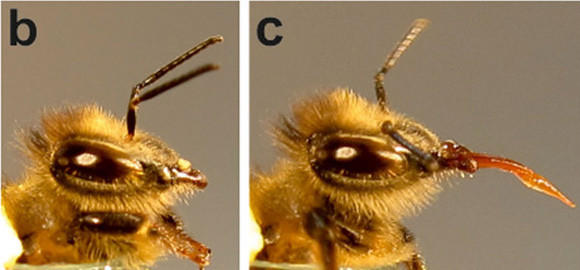 b. profitability of a food source
B. Feeding
1. Mandibles
a. Paired “teeth”
i. used to chew wood, manipulate wax, cleaning, and biting
2. Proboscis
a. to draw up liquids
i. water, nectar, and honey
b. Proboscis extension reflex
b. profitability of a food source
B. Feeding
1. Mandibles
a. Paired “teeth”
i. used to chew wood, manipulate wax, cleaning, and biting
2. Proboscis
a. to draw up liquids
i. water, nectar, and honey
b. Proboscis extension reflex  i. stimulated by contact with liquids
3. Classical conditioning of drinking
a. pairing an smell with sucrose
b. Before Conditioning
i. Odorant = CS à no response
ii. Sucrose = US à Proboscis Extension = UR
c. Conditioning produced by repeated pairing of CS with US
d. After Conditioning
i Odorant = CS à Proboscis Extension = CR
III. Brain Regions
A. several distinct bilateral structures
i. stimulated by contact with liquids
3. Classical conditioning of drinking
a. pairing an smell with sucrose
b. Before Conditioning
i. Odorant = CS à no response
ii. Sucrose = US à Proboscis Extension = UR
c. Conditioning produced by repeated pairing of CS with US
d. After Conditioning
i Odorant = CS à Proboscis Extension = CR
III. Brain Regions
A. several distinct bilateral structures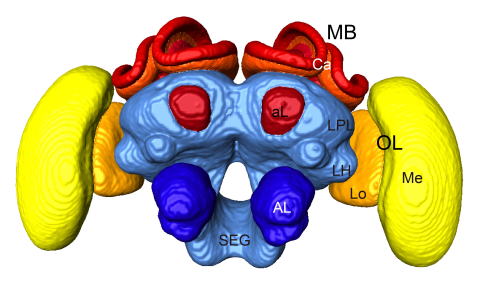 1. Antennae Lobes (AL)
2. Lateral Horn (LH)
3. Mushroom Bodies (MB)
4. Me = medulla
5. Lo = lobulus
6. Suboesophageal Ganglion (SOG)
B. Size
1. 1 mm3
a. narrow rostro-caudally
2. larger than most insect brains
a. 10X the number of neurons in a fruit fly
b. 4X the number of neurons in an ant
1. Antennae Lobes (AL)
2. Lateral Horn (LH)
3. Mushroom Bodies (MB)
4. Me = medulla
5. Lo = lobulus
6. Suboesophageal Ganglion (SOG)
B. Size
1. 1 mm3
a. narrow rostro-caudally
2. larger than most insect brains
a. 10X the number of neurons in a fruit fly
b. 4X the number of neurons in an ant
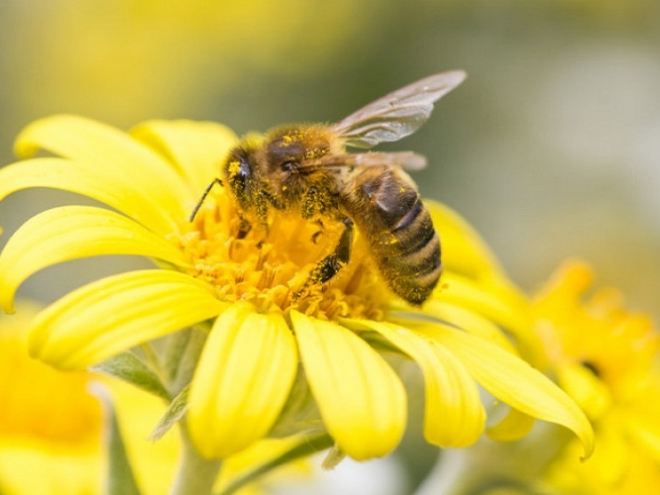
 ii. Brought from Europe and domesticated for honey production and crop pollination
B. Segmented Body – exoskeleton
1. Head
ii. Brought from Europe and domesticated for honey production and crop pollination
B. Segmented Body – exoskeleton
1. Head  a. antennae
i. composed on flagellum, pedicel, and scape
ii. 1° source of sensory information under low light conditions
1) Mechanoreceptors: touch
a) Also hearing
i) sense movement of air particles
2) Odor receptors: olfaction = smell
a) detect odorant molecules
3) Gustatory receptors: taste
b. brain
c. eyes
d. proboscis
i. used for taking in liquids
a) Nectar, water, and honey
2. Thorax
a. antennae
i. composed on flagellum, pedicel, and scape
ii. 1° source of sensory information under low light conditions
1) Mechanoreceptors: touch
a) Also hearing
i) sense movement of air particles
2) Odor receptors: olfaction = smell
a) detect odorant molecules
3) Gustatory receptors: taste
b. brain
c. eyes
d. proboscis
i. used for taking in liquids
a) Nectar, water, and honey
2. Thorax  a. Two pairs of wings
b. Three pairs of legs
i. Pollen baskets
1) located on the tibia of the hind leg
2) Lined with hairs and a long central bristle to hold onto pollen
3. Abdomen
a. Wax-producing glands (8)
i. wax scales
b. Digestive tract
c. Reproductive system
i. Females:
1) only fully developed in Queens
2) most individuals are female = workers
a) Stinger
ii. Males = drones
1) primarily exist for reproduction
a) haploid
2) fully developed testes
3) Mid-flight mating with Queen
a) lethal for males
C. Worldwide Distribution
1. Occupies every continent
a. except Antarctica
D. Bee Life Cycle
1. “Worker” bee
a. Eggs laid by single fertile Queen bee
i. Maintained and fed by “nurse” bees
b. Reach adulthood with 2-3 weeks
i. then proceed through several behavioral phenotypes
1) Nurse bee
a) cleaning the hive and feeding young
2) build comb cells
a) after royal jelly glands atrophy
b) receive nectar and pollen from foragers
3) Forager
a) older workers outside the hive
2. Queen bee
a. eggs laid in queen cups
b. fed royal jelly
i. from glands on young workers
c. developement of sexually mature female
i. due to protein-rich diet
d. Swarm
i. mating with 12-15 drones
ii. sperm storage
e. Only fertile female in the colony
i. lays 1,500 egges / day
1) during spring
f. lives 2 - 7 more years
E. Colony Life Cycle
1. Continue year after year
2. Can contain anywhere between 40,000 and 80,000 bees
3. Yearly “swarms” usually occur in the spring (may occur more or less often)
a. splitting the colony to establish a new hive
i. Requires a new queen to be born
ii. May occur when hive is too full
1) queen becomes too old, or queen dies suddenly
F. Survival
1. Thermoregulation
a. T°body 34°C is necessary for flight
i. cooler T° à shivering before flight
ii. hotter T° à regurgitate warm internal fluid
1) honey-sac contents à evaporate cooling
b. 34°C maintained in the hive
i. development of young
ii. optimal for wax creation
c. Optimal foraging T° = 22-25°C
d. immobile under 7°C
i. winter clusters
1) workers shiver à 27 - 34°C
a) edges 8-9°C
ii. winter bees livel longer
2. Predators
a. Insects
i. hornets, wasps, robber flies, dragonflies, praying mantis...
b. Arachnids
c. Amphibians
i. toads, frogs
d. Reptiles
i. lizards
e. Birds
i. bee-eaters, grackles, hummingbirds...
f. Mammals
i. bears, raccoons, honey badgers, skunks
G. Colony Collapse Disorder
1. majority of worker bees abandon the hive
2. Leave behind plenty of food
a. for the queen and nurse bees
3. Causes
a. human intervention à pesticides
i. changing keeper practices
b. Varroa-mite infestations
i. Parasitic mite - feeds on larval, pupal, and adult bees
ii. Carry viruses - impairs normal wing development
c. climate change, malnutrition, loss of genetic diversity...
4. since the early 2000’s
a. North America, Belgium, France, Ireland, the Netherlands,
Greece, Italy, Portugal, Spain, Switzerland, and Germany
b. many countries report >50% decline in bee hive stocks
II. Behavior
A. Honey Bee Dance
1. Primarily used for communication
a. Convey location/distance and
a. Two pairs of wings
b. Three pairs of legs
i. Pollen baskets
1) located on the tibia of the hind leg
2) Lined with hairs and a long central bristle to hold onto pollen
3. Abdomen
a. Wax-producing glands (8)
i. wax scales
b. Digestive tract
c. Reproductive system
i. Females:
1) only fully developed in Queens
2) most individuals are female = workers
a) Stinger
ii. Males = drones
1) primarily exist for reproduction
a) haploid
2) fully developed testes
3) Mid-flight mating with Queen
a) lethal for males
C. Worldwide Distribution
1. Occupies every continent
a. except Antarctica
D. Bee Life Cycle
1. “Worker” bee
a. Eggs laid by single fertile Queen bee
i. Maintained and fed by “nurse” bees
b. Reach adulthood with 2-3 weeks
i. then proceed through several behavioral phenotypes
1) Nurse bee
a) cleaning the hive and feeding young
2) build comb cells
a) after royal jelly glands atrophy
b) receive nectar and pollen from foragers
3) Forager
a) older workers outside the hive
2. Queen bee
a. eggs laid in queen cups
b. fed royal jelly
i. from glands on young workers
c. developement of sexually mature female
i. due to protein-rich diet
d. Swarm
i. mating with 12-15 drones
ii. sperm storage
e. Only fertile female in the colony
i. lays 1,500 egges / day
1) during spring
f. lives 2 - 7 more years
E. Colony Life Cycle
1. Continue year after year
2. Can contain anywhere between 40,000 and 80,000 bees
3. Yearly “swarms” usually occur in the spring (may occur more or less often)
a. splitting the colony to establish a new hive
i. Requires a new queen to be born
ii. May occur when hive is too full
1) queen becomes too old, or queen dies suddenly
F. Survival
1. Thermoregulation
a. T°body 34°C is necessary for flight
i. cooler T° à shivering before flight
ii. hotter T° à regurgitate warm internal fluid
1) honey-sac contents à evaporate cooling
b. 34°C maintained in the hive
i. development of young
ii. optimal for wax creation
c. Optimal foraging T° = 22-25°C
d. immobile under 7°C
i. winter clusters
1) workers shiver à 27 - 34°C
a) edges 8-9°C
ii. winter bees livel longer
2. Predators
a. Insects
i. hornets, wasps, robber flies, dragonflies, praying mantis...
b. Arachnids
c. Amphibians
i. toads, frogs
d. Reptiles
i. lizards
e. Birds
i. bee-eaters, grackles, hummingbirds...
f. Mammals
i. bears, raccoons, honey badgers, skunks
G. Colony Collapse Disorder
1. majority of worker bees abandon the hive
2. Leave behind plenty of food
a. for the queen and nurse bees
3. Causes
a. human intervention à pesticides
i. changing keeper practices
b. Varroa-mite infestations
i. Parasitic mite - feeds on larval, pupal, and adult bees
ii. Carry viruses - impairs normal wing development
c. climate change, malnutrition, loss of genetic diversity...
4. since the early 2000’s
a. North America, Belgium, France, Ireland, the Netherlands,
Greece, Italy, Portugal, Spain, Switzerland, and Germany
b. many countries report >50% decline in bee hive stocks
II. Behavior
A. Honey Bee Dance
1. Primarily used for communication
a. Convey location/distance and  b. profitability of a food source
B. Feeding
1. Mandibles
a. Paired “teeth”
i. used to chew wood, manipulate wax, cleaning, and biting
2. Proboscis
a. to draw up liquids
i. water, nectar, and honey
b. Proboscis extension reflex
b. profitability of a food source
B. Feeding
1. Mandibles
a. Paired “teeth”
i. used to chew wood, manipulate wax, cleaning, and biting
2. Proboscis
a. to draw up liquids
i. water, nectar, and honey
b. Proboscis extension reflex  1. Antennae Lobes (AL)
2. Lateral Horn (LH)
3. Mushroom Bodies (MB)
4. Me = medulla
5. Lo = lobulus
6. Suboesophageal Ganglion (SOG)
B. Size
1. 1 mm3
a. narrow rostro-caudally
2. larger than most insect brains
a. 10X the number of neurons in a fruit fly
b. 4X the number of neurons in an ant
1. Antennae Lobes (AL)
2. Lateral Horn (LH)
3. Mushroom Bodies (MB)
4. Me = medulla
5. Lo = lobulus
6. Suboesophageal Ganglion (SOG)
B. Size
1. 1 mm3
a. narrow rostro-caudally
2. larger than most insect brains
a. 10X the number of neurons in a fruit fly
b. 4X the number of neurons in an ant